JVC GZ-MG50AS, GZ-MG50AH, GZ-MG50AA, GZ-MG50AG, GZ-MG20AA User Manual
...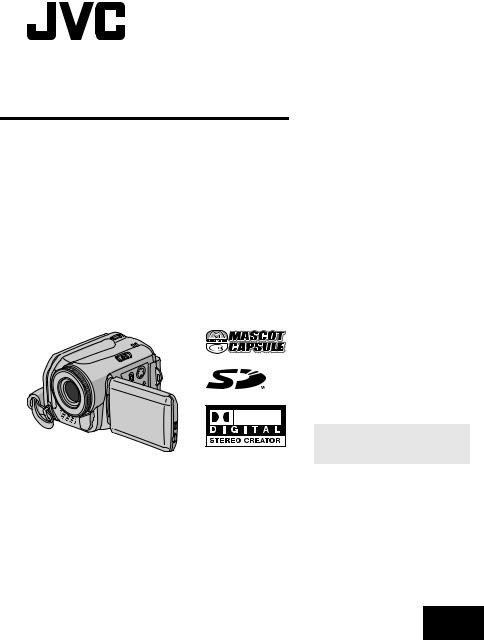
HARD DISK CAMCORDER
GZ-MG50AA/AG/AH/AS GZ-MG40AC GZ-MG30AA/AC GZ-MG20AA/AC/AG/AH/AS
ENGLISH |
|
GETTING STARTED |
7 |
VIDEO RECORDING & |
22 |
PLAYBACK |
|
STILL IMAGE RECORDING |
28 |
& PLAYBACK |
|
ADVANCED OPERATIONS |
31 |
MENU SETTINGS |
48 |
REFERENCES |
52 |
To deactivate the demonstration, set “DEMO MODE” to “OFF”. ( pg. 48)
INSTRUCTIONS
LYT1480-001B EN
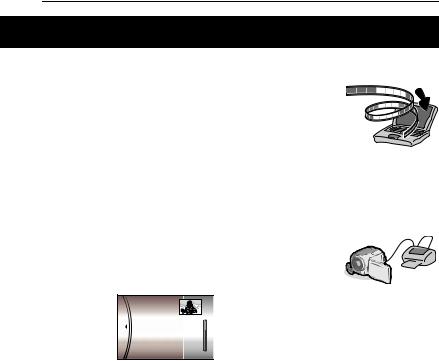
2 EN
Major Features of this Camera
Built-in Hard Disk
This hard disk camera records images to a large, built-in hard disk drive (HDD) instead of a DV tape like conventional video cameras. This enables extended hours of high-resolution, MPEG2 video recording.
Various Recording Modes
You can select the most suitable recording mode for picture quality, image size, recording time, and computer environment. ( pg. 62)
Enjoying Various Playback Features
Unlike tape operation, playback is simple and easy in this camera since no time is needed for rewinding or fast forward operations.
Playlist, playback effects, and other functions are also available for enjoying many different
types of playback.
Editing Files on your PC
USB 2.0 enables the smooth transfer of video and still images to a computer. With the bundled image editing software, you can easily
edit video and create your own DVDs. (Refer to “Read this first!” and the software installation and USB connection guide.)
Direct Printing
If your printer is
compatible with PictBridge, still images can be printed easily by
connecting the camera
with USB cable directly to the printer. ( pg. 47)

Contents |
|
GETTING STARTED |
7 |
Provided Accessories ...................................... |
7 |
Index .............................................................. |
10 |
Power ............................................................. |
14 |
Operation Mode ............................................. |
17 |
Language Setting .......................................... |
18 |
Date/Time Settings ........................................ |
18 |
Brightness Adjustment of the Display ............ |
19 |
Grip Adjustment ............................................. |
19 |
Tripod Mounting ............................................. |
19 |
Inserting/Removing an SD Card .................... |
20 |
Formatting a Recording Medium ................... |
20 |
Selecting a Recording Medium ...................... |
21 |
Remaining Space on the Recording Media ... |
21 |
Drop Detection ............................................... |
21 |
VIDEO RECORDING & PLAYBACK |
22 |
Video Recording ............................................ |
22 |
Zooming ..................................................... |
23 |
Video Playback .............................................. |
24 |
How to Use the Scroll Bar ......................... |
25 |
Date Index Screen ..................................... |
25 |
Various Playback Operations .................... |
25 |
Playback Zoom .......................................... |
25 |
Connecting to a TV, VCR or VDR .................. |
26 |
Playback on a TV ...................................... |
26 |
Dubbing to a VCR (or DVD Recorder) ....... |
26 |
Playback Using the Remote Control .............. |
27 |
STILL IMAGE RECORDING & PLAYBACK |
28 |
Still Image Recording ..................................... |
28 |
Zooming ..................................................... |
28 |
Continuous Shooting ................................. |
28 |
Still Image Playback ...................................... |
29 |
Slide Show ................................................. |
29 |
Index Screen of Still Image Files ............... |
29 |
How to Use the Scroll Bar ......................... |
30 |
Date Index Screen ..................................... |
30 |
Image Rotation .......................................... |
30 |
Playback Zoom .......................................... |
30 |
|
|
EN 3 |
ADVANCED OPERATIONS |
|
31 |
RECORDING FEATURES ..................................... |
|
31 |
Backlight Compensation ................................ |
|
31 |
Spot Exposure Control ................................... |
|
31 |
LED Light ....................................................... |
|
31 |
Manual Settings in MSET Menu .................... |
|
32 |
How to Select a Menu Item ....................... |
|
32 |
Manual Exposure ....................................... |
|
32 |
Manual Focus ............................................ |
|
33 |
White Balance ........................................... |
|
34 |
Shutter Speed ............................................ |
|
35 |
Program AE ............................................... |
|
36 |
Effect ......................................................... |
|
36 |
PLAYBACK FEATURES ....................................... |
|
37 |
Wipe or Fader Effects .................................... |
|
37 |
Playback Effects ............................................ |
|
37 |
MANAGING FILES ............................................. |
|
38 |
Viewing File Information ................................ |
|
38 |
Protecting Files .............................................. |
|
38 |
Deleting Files ................................................. |
|
39 |
Cleaning Up a Recording Medium ................. |
|
40 |
Copying/Moving Still Image Files ................... |
|
41 |
Resetting the File Number ............................. |
|
42 |
Creating Play List ........................................... |
|
42 |
Playing Back Play List ................................... |
|
43 |
DPOF Print Setting ........................................ |
|
46 |
Direct Printing with a PictBridge Printer |
......... 47 |
|
MENU SETTINGS |
|
48 |
Changing the Menu Settings ......................... |
|
48 |
Common Menus for All Modes ...................... |
|
48 |
Video Recording Menus ................................ |
|
50 |
Video Playback Menus .................................. |
|
50 |
Still Image Recording Menus ......................... |
|
51 |
Still Image Playback Menus ........................... |
|
51 |
REFERENCES |
|
52 |
Troubleshooting ............................................. |
|
52 |
Warning Indications ....................................... |
|
55 |
Cleaning the Camera ..................................... |
|
57 |
Cautions ......................................................... |
|
57 |
Specifications ................................................. |
|
60 |
TERMS ............................................... |
Back cover |
|
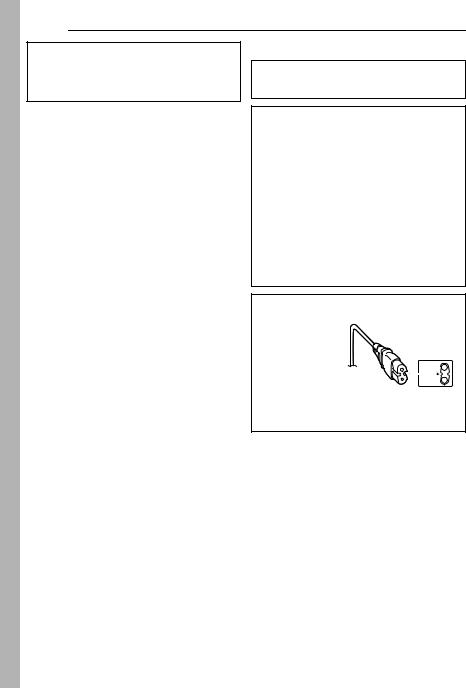
4 EN
Dear Customer,
Thank you for purchasing this hard disk camera. Before use, please read the safety information and precautions contained in the pages 4 – 5 to ensure safe use of this product.
SAFETY PRECAUTIONS
WARNING: TO PREVENT FIRE OR SHOCK HAZARD, DO NOT EXPOSE THIS UNIT TO RAIN OR MOISTURE.
CAUTIONS:
●If you notice smoke or a peculiar smell coming from the camcorder or AC Adapter, shut it down and unplug it immediately. Continue using the camcorder or AC Adapter under these conditions could lead to fire or electric shock. Contact your JVC dealer. Do not attempt to repair the malfunction yourself.
●To prevent shock, do not open the cabinet. No user serviceable parts inside. Refer servicing to qualified personnel.
●When you are not using the AC adapter for a long period of time, it is recommended that you disconnect the power cord from AC outlet.
●In certain areas, use the conversion plug depending on the type of your AC wall outlet.
CAUTION:
To avoid electric shock or damage to the unit, first firmly insert the
small end of the power cord into
the AC Adapter until it is no longer wobbly,
and then plug the larger end of the power cord into an AC outlet.

CAUTIONS:
●This camera is designed to be used with PALtype colour television signals. It cannot be used for playback with a television of a different standard. However, live recording and LCD monitor playback are possible anywhere.
●Use the JVC BN-VF707U battery pack and, to recharge it or to supply power to the camera from an AC outlet, use the provided multivoltage AC adapter. (An appropriate conversion adapter may be necessary to accommodate different designs of AC outlets in different countries.)
Do not point the lens directly into the sun. This can cause eye injuries, as well as lead to the malfunctioning of internal circuitry. There is also a risk of fire or electric shock.
CAUTION!
The following notes concern possible physical damage to the camera and to the user.
Carrying or holding the camera by the LCD monitor can result in dropping the unit, or in a malfunction.
Do not use a tripod on unsteady or unlevel surfaces. It could tip over, causing serious damage to the camera.
CAUTION!
Connecting cables (Audio/Video, S-Video, etc.) to the camera and leaving it on top of the TV is not recommended, as tripping on the cables will cause the camera to fall, resulting in damage.
EN 5
NOTES:
●The rating plate and safety caution are on the bottom and/or the back of the main unit.
●The serial number plate is on the battery pack mount.
●The rating information and safety caution of the AC adapter are on its upper and lower sides.
When the equipment is installed in a cabinet or on a shelf, make sure that it has sufficient space on all sides to allow for ventilation (10 cm) or more on both sides, on top and at the rear).
Do not block the ventilation holes.
(If the ventilation holes are blocked by a newspaper, or cloth etc. the heat may not be able to get out.)
No naked flame sources, such as lighted candles, should be placed on the apparatus.
When discarding batteries, environmental problems must be considered and the local rules or laws governing the disposal of these batteries must be followed strictly.
The apparatus shall not be exposed to dripping or splashing.
Do not use this equipment in a bathroom or places with water.
Also do not place any containers filled with water or liquids (such as cosmetics or medicines, flower vases, potted plants, cups etc.) on top of this unit. (If water or liquid is allowed to enter this equipment, fire or electric shock may be caused.)
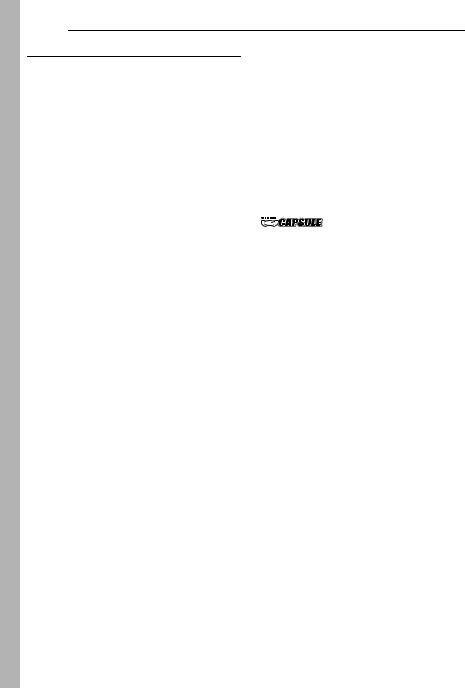
6 EN
Before Using this Camera
This camera records video in MPEG2 format compliant with SD-VIDEO format.
Remember that this camera is not compatible with other digital video formats.
Remember that this camera is intended for private consumer use only.
Any commercial use without proper permission is prohibited. (Even if you record an event such as a show, performance or exhibition for personal enjoyment, it is strongly recommended that you obtain permission beforehand.)
Do not strike or shake the hard disk.
Before recording important video, be sure to make a trial recording.
Play back your trial recording to make sure the video and audio have been recorded properly.
Make a backup of important recorded data
Protect your important recorded data by copying the files to PC. It is recommended to copy it from your PC to a DVD or other recording media for storage. Refer to the software installation and USB connection guide.
Important notes when requesting repair or inspection
When the camera is repaired or inspected, data may be erased, and the hard disk may be formatted. Back up all data before requesting repair or inspection.
If a problem occurs with the SD Memory Card, bring the card together with the camera.
When requesting repairs for breakdowns by your dealer or JVC service centre, be sure to bring your camera together with the SD Memory Card. If one of them is not included, the cause cannot be diagnosed, and the repair cannot be made properly.
Important notes for destroying and disposing of camera
When formatting or erasing data using the camera or PC functions, only the file administration information is changed. The data is not completely erased from the hard disk. If you want to completely erase all of the data, we recommend either using commercially available software that is specially designed for that purpose, or by physically destroying the camera with a hammer etc.
Also read “Cautions” on pages 57 to 59.
●Manufactured under license from Dolby Laboratories. “Dolby” and double-D symbol are trademarks of Dolby Laboratories.
●



MascotCapsule is registered trademark of HI CORPORATION in Japan.
Copyright © 2001 HI CORPORATION. All rights reserved.
●Other product and company names included in this instruction manual are trademarks and/or registered trademarks of their respective holders.
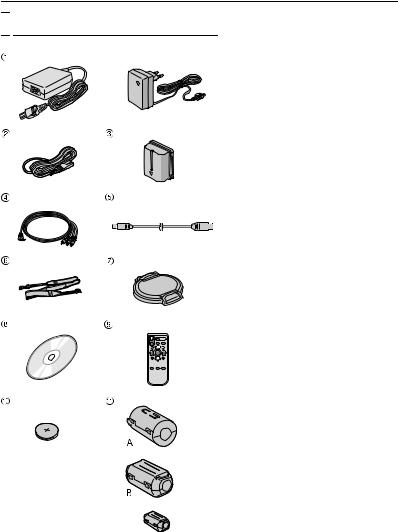

 Provided Accessories
Provided Accessories
OR
GETTING STARTED EN 7
a AC Adapter AP-V14E, AP-V17E, AP-V14A or |
|
|
AP-V14AC |
|
|
b Power Cord (AP-V14E only) |
|
|
c Battery Pack BN-VF707U |
STARTED |
|
|
||
d Audio/Video Cable |
|
|
e USB Cable (Refer to the software installation |
|
|
and USB connection guide.) |
GETTING |
|
f Shoulder Strap (See page 8 for attachment) |
||
|
||
g Lens Cap (See page 8 for attachment) |
|
|
h CD-ROM |
|
|
i Remote Control Unit RM-V730US |
|
|
j Lithium Battery CR 2025* (for remote control |
|
|
unit) |
|
|
k Core Filter for Cables (See page 9 for |
|
|
attachment) |
|
|
Large-A (x 1): Audio/Video Cable |
|
|
Large-B (x 2): USB/S-Video Cable |
|
|
Small (x 1): DC Cord |
|
*A lithium battery is pre-installed in the remote control unit at time of shipment (with insulation sheet). To use the remote control unit, remove the insulation sheet.
NOTES:
●In order to maintain optimum performance of the camera, provided cables may be equipped with one or more core filter. If a cable has only one core filter, the end that is closest to the filter should be connected to the camera.
●Make sure to use the provided cables for connections. Do not use any other cables.
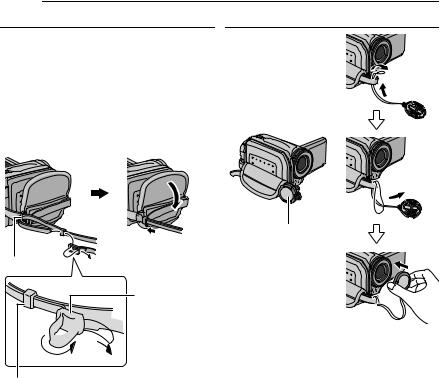
8 EN GETTING STARTED
Attaching the Shoulder Strap
Follow the illustration.
1 Open the velcro strip.
2 Thread the strap through the eyelet.
3 Fold it back and thread it through the strap guide and the buckle.
●To adjust the length of the strap, loosen and then tighten the strap in the buckle.
4 Slide the strap guide fully towards the eyelet.
5 Close the velcro strip.
 1
1 
 5
5
2 |
4 |
Eyelet
Buckle
3

Attaching the Lens Cap
To protect the lens, attach the provided lens cap to the camera as shown in the illustration.
NOTE:
To confirm the lens cap is on correctly, make sure the cap is flush to the camera.
Place here during recording.
Strap Guide
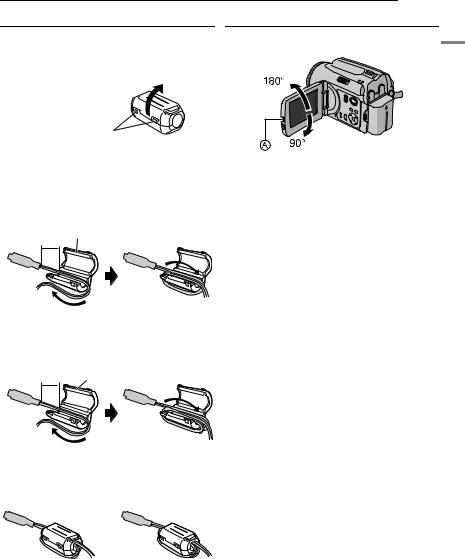
GETTING STARTED EN 9
Attaching the Core Filter |
LCD Monitor |
Attach the core filters to the cables. The core filter reduces interference.
1 Release the stoppers on both ends of the core filter.
Stopper
2 Run the cable through the core filter, leaving approx. 3 cm of cable between the cable plug and the core filter.
S-Video/Audio/Video/USB cable
Wind the cable once around the outside of the core filter as shown in the illustration.
3 cm Core Filter (Large)
Wind once.
DC cord
Wind the cord twice around the outside of the core filter as shown in the illustration.
3 cm Core Filter (Small)
Wind twice.
● Wind the cable so that it is not slack.
3 Close the core filter until it clicks shut.
Pull on the end  of the LCD monitor and open the LCD monitor fully. It can rotate 270°.
of the LCD monitor and open the LCD monitor fully. It can rotate 270°.
GETTING STARTED
S-Video/Audio/Video/ |
DC Cord |
USB Cable |
NOTES:
●Take care not to damage the cable.
●When connecting a cable, attach the end with the core filter to the camera.
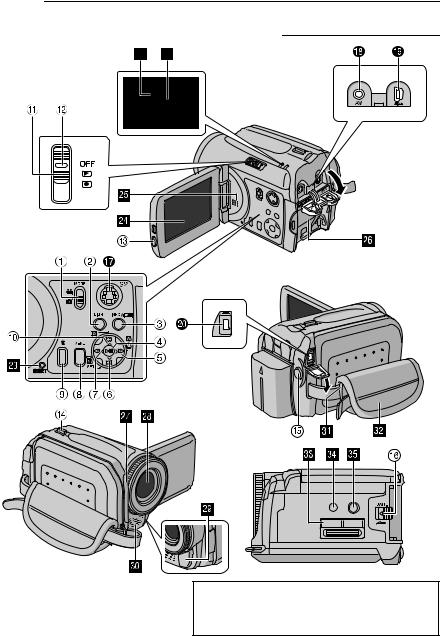
10 EN GETTING STARTED
 Index
Index
ATTENTION:
●Be careful not to cover b, c, d, and e during shooting.
●Be careful not to cover Y during playback.
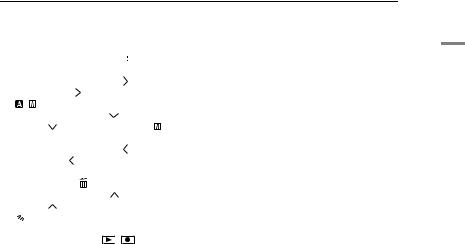
GETTING STARTED EN 11
Controls
a Mode Switch [MODE] ( pg. 17) b Light Button [LIGHT] ( pg. 31)
c Information Button [INFO/
 ] ( pg. 38) d Play/Pause Button [49] ( pg. 24, 29)
] ( pg. 38) d Play/Pause Button [49] ( pg. 24, 29)
e Forward Search Button [ |
(5)] ( pg. 25)/ |
||||
Right Button [ |
]/Auto/Manual Mode Switch |
||||
[ |
/ ] ( pg. 17) |
|
|||
f Forward Skip Button [ |
] ( pg. 25)/Down |
||||
Button [ |
]/Manual Set Button [ SET] |
||||
( pg. 32) |
|
|
|
||
g Reverse Search Button [ |
(3)] ( pg. 25)/ |
||||
Left Button [ ] |
|
|
|||
h Menu Button [MENU] ( pg. 48) |
|||||
i Delete Button [ |
] ( pg. 39) |
||||
j Reverse Skip Button [ |
] ( pg. 25)/Up |
||||
Button [ |
]/Backlight Compensation Button |
||||
[ |
|
] ( pg. 31)/Spot Exposure Control |
|||
|
|||||
Button ( pg. 31) |
|
||||
k Power Switch [OFF, , |
] ( pg. 17) |
||||
l Lock Button ( pg. 17) |
|
||||
m LCD Lock Button |
|
||||
n Zoom Lever [T/W] ( pg. 23) Speaker Volume Control ( pg. 24)
o Recording Start/Stop Button ( pg. 22, 28) p Battery Release Button [BATT.] ( pg. 14)
Indicators
U Power/Charge Lamp [POWER/CHARGE] ( pg. 14, 17)
V Access Lamp [ACCESS] (Lights up or blinks when you access to any files. Do not turn off the power or remove the battery pack/AC adapter while accessing to files during recording or playback.)
Other Parts
WReset Hole [RESET] ( pg. 52) XLCD Monitor
YSpeaker ( pg. 24)
aBattery Pack Mount ( pg. 14) bRemote Sensor ( pg. 27)
Camera Sensor
cLens
dLED Light ( pg. 31)
eStereo Microphone
fShoulder Strap Eyelet ( pg. 8)
gGrip Strap ( pg. 19)
hSD Card Cover ( pg. 20)
iStud Hole ( pg. 19)
jTripod Mounting Socket ( pg. 19)
GETTING STARTED
Connectors
The connectors are located beneath the covers. Q S-Video Output Connector [S] ( pg. 26)
R Audio/Video Output Connector [AV]
S USB (Universal Serial Bus) Connector (Refer to the software installation and USB connection guide.)
T DC Input Connector [DC] ( pg. 14)
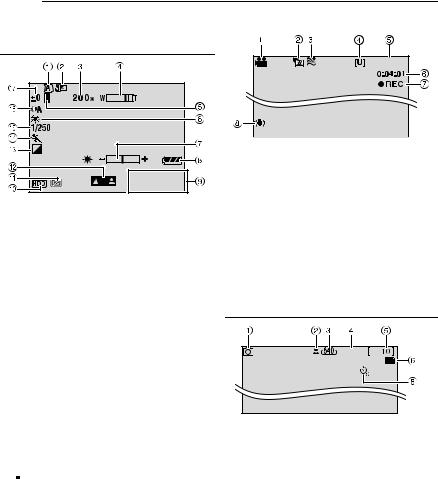
12 EN GETTING STARTED
Indications on LCD Monitor |
During Video Recording only |
During both Video and Still Image Recording |
|
11:30 |
10.11. 2005 |
a Manual Mode Indicator ( pg. 17)
 : Auto Mode
: Auto Mode
 : Manual Mode
: Manual Mode
b Tele Macro Mode Indicator ( pg. 50) c Approximate Zoom Ratio ( pg. 23, 50) d Zoom Indicator ( pg. 23, 50)
e Iris Lock Indicator ( pg. 31, 32) f White Balance Indicator ( pg. 34)
g Brightness Control Indicator ( pg. 19, 49) h Battery Indicator ( pg. 55)
i Date/Time ( pg. 49)
j Selected Medium Indicator ( pg. 21, 49) k Drop Detection Indicator ( pg. 21)
l Manual Focus Adjustment Indicator ( pg. 33)
m Effect Mode Indicator ( pg. 36)
n Program AE Mode Indicator ( pg. 36) o Shutter Speed ( pg. 35)
 : Nightscope Indicator p Light Indicator ( pg. 31)
: Nightscope Indicator p Light Indicator ( pg. 31)
q ±: Exposure Adjustment Indicator ( pg. 32)
 : Backlight Compensation Indicator ( pg. 31)
: Backlight Compensation Indicator ( pg. 31)
 : Spot Exposure Control Indicator ( pg. 31)
: Spot Exposure Control Indicator ( pg. 31)
[0h56m]
a Mode Indicator ( pg. 17)
b Wide Mode Indicator ( pg. 50) c Wind Cut Indicator ( pg. 50)
d Picture Quality: [U] (ultra fine), [F] (fine), [N] (normal), [E] (economy) ( pg. 50)
e Remaining Time ( pg. 22, 62) f Counter ( pg. 49)
g 7REC: (Appears during recording.) ( pg. 22)
79: (Appears during record-standby mode.) ( pg. 22)
h Digital Image Stabiliser (DIS) Indicator ( pg. 50)
During Still Image Recording only
FINE
PHOTO 
a Mode Indicator ( pg. 17) b Focus Icon ( pg. 28)
c Image Size: 1152 (1152 x 864)*, 1024 (1024 x 768)*, 640 (640 x 480) ( pg. 51)
*Not available for GZ-MG30AA/AC, GZ-MG20AA/ AC/AG/AH/AS.
d Picture Quality: FINE (fine) or STD (standard) ( pg. 51)
e Remaining Number of Shots ( pg. 63) f : Continuous Shooting Mode Indicator
: Continuous Shooting Mode Indicator
( pg. 28)
g Shooting Icon ( pg. 28)
h Self-Timer Recording Indicator ( pg. 51)

|
|
GETTING STARTED EN 13 |
|
During Video Playback |
|
During Still Image Playback |
|
|
|
|
|
10. 11. 2005 |
a Mode Indicator ( pg. 17)
b Play List Playback Indicator (Appears when play list is played back. pg. 43)
c Picture Quality: [U] (ultra fine), [F] (fine), [N] (normal), [E] (economy) ( pg. 50)
d Playback Mode ( pg. 24) U : Playback
9 : Pause
5 : Forward High-Speed Search
3 : Reverse High-Speed Search
9U : Forward Slow-Motion
Y9 : Reverse Slow-Motion
(The number on the left shows speed.) e Counter ( pg. 49)
f Volume Level Indicator
g Battery Indicator ( pg. 55) h Date ( pg. 49)
i Selected Medium Indicator ( pg. 21, 49) j Effect Mode Indicator ( pg. 36)
k Wipe/Fader Effect Indicator ( pg. 37, 50)
11:30 10. 11. 2005
a Mode Indicator ( pg. 17) b Folder/File Number
c Slide Show Playback Indicator ( pg. 29) d Battery Indicator ( pg. 55)
e Date/Time ( pg. 49)
f Selected Medium Indicator ( pg. 21, 49)
NOTE:
When the mode indicators disappear or blink, the functions of those modes are not available. Such a phenomenon also occurs when the LCD monitor is turned 180°. ( pg. 9)
GETTING STARTED
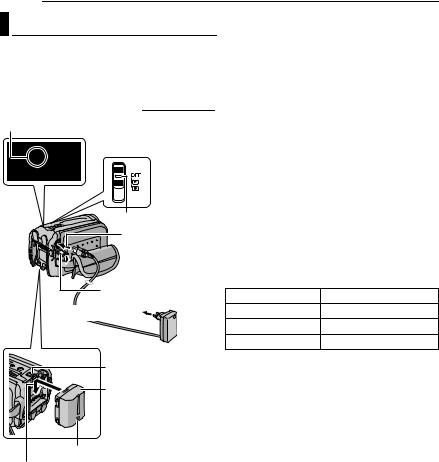
14 EN GETTING STARTED
Power |
1 Set the power switch to OFF. |
||
2 With the arrow on the battery pack pointing |
|||
|
|||
This camera’s 2-way power supply system lets |
downward, push the battery pack slightly against |
||
you choose the most appropriate source of |
the battery pack mount. |
||
power. Do not use provided power supply units |
● If the battery mount cover is attached, remove it |
||
with other equipment. |
by sliding BATT. |
|
|
3 Slide down the battery pack until it locks in |
|||
Charging the Battery Pack |
|||
place. |
|
||
Power/Charge Lamp |
4 Connect the AC adapter to the camera. |
||
5 Connect the power cord to the AC adapter. |
|||
|
|||
Power Switch |
(AP-V14E only) |
|
|
6 Plug the power cord into an AC outlet. The |
|||
|
|||
|
power/charge lamp on the camera blinks to |
||
|
indicate charging has started. |
||
|
7 When the power/charge lamp goes out, |
||
Lock Button |
charging is finished. Unplug the power cord from |
||
the AC outlet. Disconnect the AC adapter from |
|||
To DC connector |
the camera. |
|
|
|
To detach the battery pack |
||
|
While sliding BATT., remove the battery pack. |
||
Open the cover. |
Required charging time |
||
Battery pack |
Charging time |
||
|
|||
To AC outlet |
BN-VF707U* |
Approx. 1 hr. 30 min. |
|
|
BN-VF714U |
Approx. 2 hr. 40 min. |
|
AC Adapter |
BN-VF733U |
Approx. 5 hr. 40 min. |
|
* Provided |
|
||
(ex. AP-V17E) |
|
||
BATT. |
Battery Pack |
Arrow |
Battery Pack Mount |

NOTES:
●This product includes patented and other proprietary technology and will operate only with JVC Data Battery. Use the JVC BNVF707U/VF714U/VF733U battery packs. Using generic non-JVC batteries can cause damage to the internal charging circuitry.
●If the protective cap is attached to the battery pack, remove it first.
●During charging, the camera cannot be operated.
●Charging is not possible if the wrong type of battery is used.
●Make sure to use the battery pack with the arrow ( ) mark. The camera does not turn on with the battery mount cover without the arrow (
) mark. The camera does not turn on with the battery mount cover without the arrow ( ) mark.
) mark.
●When charging the battery pack for the first time or after a long storage period, the power/charge lamp may not light. In this case, remove the battery pack from the camera, then try charging again.
●If the battery operation time remains extremely short even after having been fully charged, the battery is worn out and needs to be replaced.
Please purchase a new one.
●Since the AC adapter processes electricity internally, it becomes warm during use. Be sure to use it only in well-ventilated areas.
●Using the optional AA-VF7 battery charger, you can charge the BN-VF707U/VF714U/VF733U battery pack without the camera.
●After 5 minutes has elapsed in record-standby mode, the camera will automatically turn off its power supplied from the AC adapter. In this case, the battery charge starts if the battery is attached to the camera.
GETTING STARTED EN 15
Using the Battery Pack |
|
|
||
Perform steps 2 – 3 in “Charging the Battery |
|
|
||
Pack”. |
|
STARTED |
||
|
Battery pack |
Recording time |
||
Maximum continuous recording time |
|
|
||
|
|
|
GETTING |
|
|
BN-VF714U |
Approx. 2 hr. 10 min. |
||
|
BN-VF707U* |
Approx. 1 hr. 00 min. |
|
|
|
|
(55 min.) |
|
|
|
|
(2 hr. 00 min.) |
|
|
|
|
|
|
|
|
BN-VF733U |
Approx. 5 hr. 00 min. |
|
|
|
|
(4 hr. 45 min.) |
|
|
|
|
|
|
|
* |
Provided |
|
|
|
( |
): When the LED light is on. |
|
|
|
NOTES:
●Recording time is reduced significantly under the following conditions:
•Zoom or record-standby mode is engaged repeatedly.
•Playback mode is engaged repeatedly.
●Before extended use, it is recommended that you prepare enough battery packs to cover 3 times the planned recording time.
ATTENTION:
●Before detaching the power source, make sure that the camera’s power is turned off. Failure to do so can result in a camera malfunction.
●If the camera is a subject to electrostatic discharge, turn the power off before using it again.
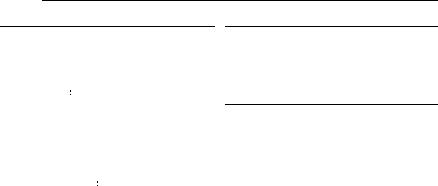
16 EN GETTING STARTED
Data Battery System Using AC Power
You can check the remaining battery power and the recordable time.
1
2 Open the LCD monitor fully.
3 Press INFO/
 repeatedly, and the battery status screen appears.
repeatedly, and the battery status screen appears.
●It is displayed for approx. 3 seconds if the button is pressed and released quickly, and for approx. 15 seconds if the button is pressed and held for several seconds.
●If “COMMUNICATING ERROR” appears instead of the battery status even though you tried to press INFO/
 several times, there may be a problem with your battery. In such a case, consult your nearest JVC dealer.
several times, there may be a problem with your battery. In such a case, consult your nearest JVC dealer.
●The recordable time display should only be used as a guide. It is displayed in 10 minute units.
Perform step 4 in “Charging the Battery Pack”.
NOTE:
The provided AC adapter features automatic voltage selection in the AC range from 110 V to 240 V.
About Batteries
DANGER! Do not attempt to take the batteries apart, or expose them to flame or excessive heat, as it may cause a fire or explosion. WARNING! Do not allow the battery or its terminals to come in contact with metals, as this can result in a short circuit and possibly start a fire.
To resume the original function of the accurate battery power indication
If the battery power indication differs from the actual operating time, fully charge the battery, and then run it down. However this function may not turn back if the battery was used for a long period of time under extremely high/low temperature condition or charged too many times.

GETTING STARTED EN 17
Operation Mode |
2 Recording/Playback Mode |
|||||
Select the recording/playback mode using the |
||||||
To turn on the camera, set the power switch to |
||||||
MODE switch. |
|
|
||||
or |
while pressing down the lock button |
: Video mode ( pg. 22, 24) |
||||
located on the switch. |
||||||
: Still image mode ( pg. 28, 29) |
||||||
● The power/charge lamp turns on. |
||||||
|
|
|
||||
To turn off the camera, set the power switch to |
3 Auto/Manual Mode |
|
||||
OFF. |
|
|
|
|||
1 Power Switch |
|
Press and hold |
( / |
) to switch the auto/ |
||
|
manual recording mode. When manual mode is |
|||||
|
|
|
||||
|
|
Power/Charge Lamp |
selected, the indicator |
appears on the LCD |
||
|
|
|
monitor. |
|
|
|
|
|
|
Auto mode: |
|
||
|
|
|
You can record using no special |
|||
|
|
|
effects or manual adjustments. |
|||
|
2 MODE |
Lock Button |
Manual mode: |
|||
|
|
|||||
LCD Monitor |
3 |
Manual recording is possible by |
||||
|
|
|
setting various functions. |
|||
|
|
|
( pg. 31 – 37) |
|||
Set the appropriate operation mode according to |
To return to the auto recording mode |
|||||
your preference using the power and MODE |
||||||
switches and ( / |
) button. |
Press ( / |
) again so that the indicator |
|||
|
|
|
appears. |
|
|
|
1 Power Switch Position
Set the power switch for recording ( ) or playback (
) or playback ( ) while pressing down the lock button.
) while pressing down the lock button.
Power Switch
Power Off


 Playback
Playback
 Recording
Recording
4 Power-Linked Operation
When the power switch is set to  , you can also turn on/off the camera by opening/closing the LCD monitor.
, you can also turn on/off the camera by opening/closing the LCD monitor.
GETTING STARTED
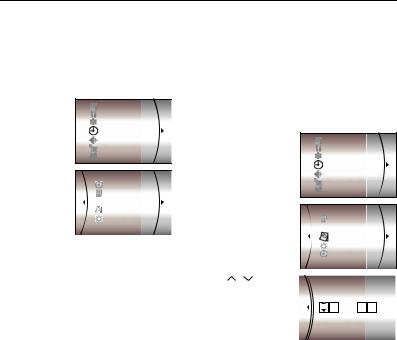
18 EN GETTING STARTED
|
|
Language Setting |
|
|
|
Date/Time Settings |
The language on the display can be changed. ( pg. 48, 49)
1 Set the power switch to  or
or  .
.
2 Press MENU. The menu screen appears.
3 Press  /
/  to select [DISPLAY], then press 49.
to select [DISPLAY], then press 49.
4 Press  /
/  to select [LANGUAGE], then press 49.
to select [LANGUAGE], then press 49.
5 Press  /
/  to select the desired language, then press
to select the desired language, then press
49.
6 Press MENU to return to the
The recording start date/time is recorded on the video/still image file and it can be checked by pressing INFO during playback. ( pg. 24, 29) In addition, you can find the desired file by the date index screen. ( pg. 30)
1 Set the power switch to  or
or  .
.
2 Press MENU. The menu screen appears.
3 Press  /
/  to select [DISPLAY], then press 49.
to select [DISPLAY], then press 49.
4 Press  /
/  to select [CLOCK ADJUST], then press 49. The day is highlighted.
to select [CLOCK ADJUST], then press 49. The day is highlighted.
5 Press |
/ |
to input |
|
|
|
|
|
CLOCK ADJUST |
|||||
the day, then press 49. |
|
|||||
|
DATE |
|
TIME |
|||
Repeat to input the |
|
|
||||
|
|
|
|
|||
month, year, hour and |
|
31 01 |
2005 |
11 : 07 |
||
|
|
|
|
|||
minute. |
|
|
|
|
|
|
6 Press MENU to |
|
|
|
|
||
|
|
|
|
|||
return to the normal screen. |
|
|
|
|||
Built-in Clock’s Rechargeable Lithium Battery
If the camera is not used for approx. 3 months, the clock’s lithium battery will become discharged and the date/time stored in memory will be lost. When this occurs, first connect the camera to an AC outlet using the AC adapter for over 24 hours to charge the clock’s rechargeable lithium battery. Then perform the date/time setting before using the camera.
Note that the camera can be used without setting the date/time.
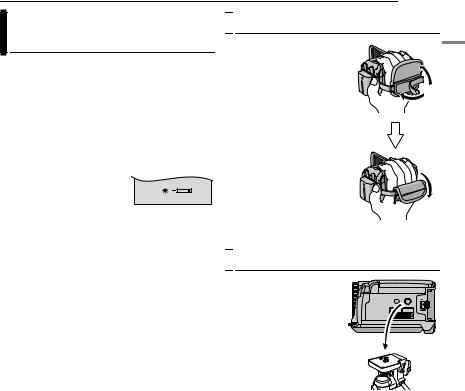
GETTING STARTED EN 19
Brightness Adjustment of the
Display
The brightness of the display can be adjusted.
1 Set the power switch to  or
or  while pressing down the lock button located on the switch.
while pressing down the lock button located on the switch.
2 Open the LCD monitor fully. ( pg. 9)
3 Press MENU. The menu screen appears.
4 Press  /
/  to select [DISPLAY], then press
to select [DISPLAY], then press
49.
5 Press  /
/ to select [BRIGHT], and press 49. The brightness control indicator appears.
to select [BRIGHT], and press 49. The brightness control indicator appears.
6 Press  /
/  until the appropriate brightness is reached.
until the appropriate brightness is reached.
7 Press 49 to clear the brightness control indicator from the display.

 Grip Adjustment
Grip Adjustment
1 Adjust the velcro strip.
2 Pass your right hand through the loop and grasp the grip.
3 Adjust your thumb and fingers through the grip to easily operate the recording start/stop button, power switch and zoom lever. Be sure to fasten the velcro strip to your preference.

 Tripod Mounting
Tripod Mounting
To attach the camera to a tripod, align the direction stud and screw to the mounting socket and stud hole on the camera. Then tighten the screw clockwise.
● Some tripods are not equipped with studs.
GETTING STARTED
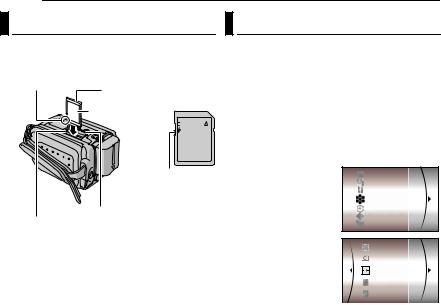
20 EN GETTING STARTED
Inserting/Removing an SD Card |
Formatting a Recording Medium |
|
You can use an SD card as a recording medium |
You can format (initialise) the built-in hard disk |
|
in the SD slot. See page 62 for the guaranteed |
(HDD) or SD cards. You have to format the |
|
media to work with this camera. |
newly-purchased SD cards with this camera |
|
Clipped Edge |
before using them. This enables stable speeds |
|
and operation when accessing the recording |
||
SD Card (optional) |
||
Label |
medium. Be aware that all files and data |
|
including protected files will be erased. |
||
|
( pg. 38) |
Write/Erase
Protection Tab
SD Card Cover
SD Slot
1 Set the power switch to  or
or  .
.
2 Press MENU. The menu screen appears.
3 Press  /
/ to select [REC MEDIA SETTING], then press 49.
to select [REC MEDIA SETTING], then press 49.
1 Make sure the camera’s power is off.
2 Open the SD card cover.
3 To insert an SD card, firmly insert it with its clipped edge first.
To remove an SD card, push it once. After the SD card comes out of the camera, pull it out.
●Do not touch the terminal on the reverse side of the label.
4 Close the SD card cover.
To protect valuable files
Slide the write/erase protection tab on the side of the SD card in the direction of “LOCK”. This prevents the SD card from being recorded over. To record on this SD card, slide the tab back to the position opposite to “LOCK” before inserting it.
NOTE:
Before using a new SD card, it is necessary to format the card. ( pg. 20)
ATTENTION:
Do not insert or remove the SD card while the camera is turned on, as this may cause the SD card to be corrupted or cause the camera to become unable to recognise whether or not the SD card is installed.
4 Press  /
/ to select [FORMAT], then press
to select [FORMAT], then press
49.
5 Press  /
/ to select [HDD] or [SD], then press 49.
to select [HDD] or [SD], then press 49.
6 Press  /
/ to select [EXECUTE], then press 49.
to select [EXECUTE], then press 49.
●By pressing the 49 button while selecting [HDD]
and holding down the  button in step 5, you can erase the data on the hard disk in a format that is difficult to recover. Moreover, by repeating this procedure, you can make the data even more difficult to recover. When formatting in this way, a formatting progress bar is displayed.
button in step 5, you can erase the data on the hard disk in a format that is difficult to recover. Moreover, by repeating this procedure, you can make the data even more difficult to recover. When formatting in this way, a formatting progress bar is displayed.
●To cancel the formatting, select [CANCEL], then press 49.
CAUTION:
Do not remove the SD card or perform any other operation (such as turning off the power) during format. Also, be sure to use the provided AC adapter, as the recording medium may be corrupted if the battery becomes exhausted during format. If the recording medium becomes corrupted, format it again.
NOTE:
Do not format the recording medium on the PC. Make sure to format the recording medium on the camera.
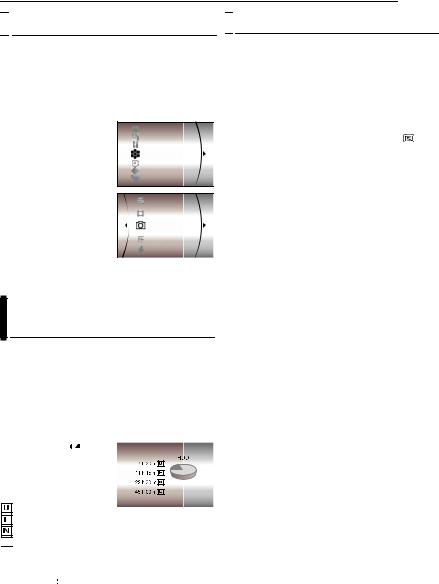

 Selecting a Recording Medium
Selecting a Recording Medium
Select the recording medium before starting recording or playback. ( pg. 48, 49) Example: When recording still images to an SD card
1 Set the power switch to  or
or  .
.
2 Press MENU. The menu screen appears.
3 Press  /
/  to select [REC MEDIA SETTING], then press 49.
to select [REC MEDIA SETTING], then press 49.
4 Press  /
/  to select [IMAGE MODE], then press 49.
to select [IMAGE MODE], then press 49.
5 Press  /
/  to select [SD], then press 49.
to select [SD], then press 49.
6 Press MENU to return to the normal screen.
Remaining Space on the Recording Media
This enables you to check the remaining space on the recording media and the available recording time for each picture quality mode. Before checking, set the recording media that you want to check in [REC MEDIA SETTING]. ( pg. 48, 49)
Example: When checking the HDD space
1 Set the power switch to  .
.
2 Press INFO/ |
|
|
. The |
|
|
|
|
|
|
|
|
MAX RECORDING TIME |
|||||
MAX RECORDING TIME |
|
|
|
|
|
|||
screen appears. |
|
|
|
|
|
|||
Displayed picture |
|
|
|
FREE |
|
|||
|
|
|
|
|||||
quality mode |
|
|
|
USED |
|
|||
|
|
|
|
|
||||
: ULTRA FINE |
|
|
|
|
|
|||
|
|
|
|
|
||||
: FINE |
|
|
|
|
|
|||
: NORMAL |
|
|
|
|
|
|||


 : ECONOMY
: ECONOMY
For details on the picture quality, see page 50.
To return to the normal screen
Press INFO/
 repeatedly.
repeatedly.
GETTING STARTED EN 21

 Drop Detection
Drop Detection
This function turns off the power automatically to |
|
|
STARTED |
||
prevent HDD damage when the camera is |
||
|
||
accidentally dropped. This function is set to on |
|
|
at time of shipment. |
|
|
If the power is turned off due to the drop |
GETTING |
|
detection function, set the power switch to OFF, |
||
|
||
and turn the power on again. |
|
|
To turn off this function |
|
|
Set [DROP DETECTION] to [OFF]. The |
|
|
indicator appears. ( pg. 49) |
|
CAUTION:
Setting this function to off increases the chances of damaging the internal hard disk if the camera is accidentally dropped.
NOTES:
●This function cannot protect the hard disk every single time it is dropped.
● The  indicator is only displayed when this function is set to [OFF]. For normal use, set this function to [ON].
indicator is only displayed when this function is set to [OFF]. For normal use, set this function to [ON].
●If the drop detection function operates when the camera has not been dropped, set the function to [OFF] to continue use.
●If a drop is detected during shooting, the file being shot when the camera was dropped may be saved in the [EXTMOV] folder. ( pg. 22)
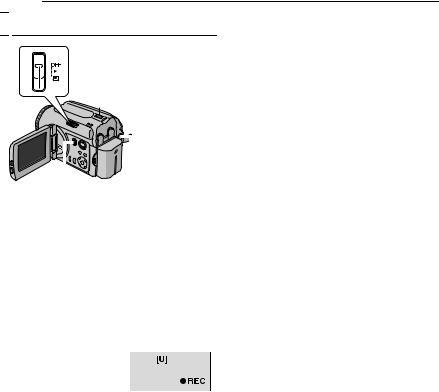
22 EN VIDEO RECORDING & PLAYBACK

 Video Recording
Video Recording
 Power Switch
Power Switch
 Lock Button
Lock Button
 Zoom Lever
Zoom Lever
|
|
|
|
|
|
|
|
|
|
|
|
MODE |
Recording Start/Stop |
||||
|
|
|
Button |
||
1 Set the power switch to  .
.
2 Set the MODE switch to .
.
●The camera is programmed to record videos on the built-in hard disk by the factory-preset. To switch the recording medium, see pages 21, 48 and 49.
●To change the picture quality, see pages 48 and 50.
●To use the light, see page 31.
3 Press the recording start/stop button to start recording.
● Approximate remaining time |
|
|
[0h56m] |
||
for recording appears on |
||
the display. |
|
4 To stop recording, press
the recording start/stop button again.
NOTES:
●If the camera is left without any operation during recording or playback (video or still image) for
5 minutes when using the battery pack, the camera is turned off automatically to conserve power. To turn the camera on again, set the power
switch to OFF, then to  or
or  . When using the AC adapter, the camera enters the sleep mode (the access lamp lights and the LCD monitor turns off). To cancel the sleep mode, perform any operation such as zooming.
. When using the AC adapter, the camera enters the sleep mode (the access lamp lights and the LCD monitor turns off). To cancel the sleep mode, perform any operation such as zooming.
●When the camera heats up, the 7REC indicator flashes. If the camera continues to heat up, shooting may be stopped to protect the recording medium. In this case, turn off the camera power, and then wait until the camera cools down.
( pg. 56)
●If data cannot be recorded or saved properly, the video files are not saved to the [SD_VIDEO] folder for regular video. Instead, the files are saved to the [EXTMOV] folder. To play back these files, see “To play back files in the [EXTMOV] folder”
( pg. 24).
●There may be differences in the brightness between the recorded video and still image, even if the same subject is shot.
●Video file names are assigned as sequential hexadecimal numbers. For example, starts from 1 to 9 followed by A to F.
●To turn the operation sounds off, see page 48.
●For approximate recording time, see page 62.
●After recording video for 12 consecutive hours, the recording will be stopped automatically.
●When recording video, a new file will be created for every 4 GB of contiuous shooting.
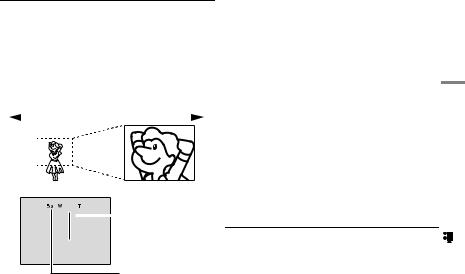
|
VIDEO RECORDING & PLAYBACK EN 23 |
|
Zooming |
NOTES: |
|
Use the zoom function for close-up or wideangle shooting. You can zoom in up to 15x* by using the optical zoom.
To zoom in
Slide the zoom lever towards T (telephoto).
To zoom out
Slide the zoom lever towards W (wide-angle).
W: Wide angle |
|
T: Telephoto |
||||||
|
|
|
|
|
|
|
|
|
|
|
|
|
|
|
|
|
|
|
|
|
|
|
|
|
|
|
|
|
|
|
|
|
|
|
|
●The S-Video cable is optional. Be sure to use the YTU94146A S-Video cable. Consult the JVC Service Centre described on the sheet included in the package for details on its availability. Make sure to connect the end with a core filter to the camera. The core filter reduces interference.
●Focusing may become unstable during zooming. In this case, set the zoom before recording and lock the focus by using the manual focus
( pg. 33), then zoom in or out during recording.
●During digital zoom, the quality of image may suffer.
●Macro shooting is possible as close as approx.
5 cm to the subject when the zoom lever is set all the way to W.
●When you zoom into a subject close to the lens, the camera may automatically zoom out depending on the distance to the subject. In this case, set [TELE MACRO] to [ON]. ( pg. 50)


 Digital zoom zone
Digital zoom zone
15x* (Optical) zoom  zone
zone
Approximate zoom
ratio
●The further you slide the zoom lever, the quicker the zoom action.
●Zoom magnification over 15x* is done through digital image processing, and is therefore called
digital zoom. Digital zooming is possible up to 700x*. Set [ZOOM] to [60X] or [700X]*. ( pg. 50)
*For GZ-MG30AA/AC/GZ-MG20AA/AC/AG/AH/AS optical zoom can go up to 25x, digital zoom – up to 800x, and [ZOOM] can be set to [100X] or [800X].
Deleting Files
If you press  during recording mode, the file recorded most recently will be deleted.
during recording mode, the file recorded most recently will be deleted.
( pg. 39)
●However, if the recording mode (video or still image) is switched or the power is turned off and on again after recording, you cannot delete the file.
VIDEO RECORDING & PLAYBACK
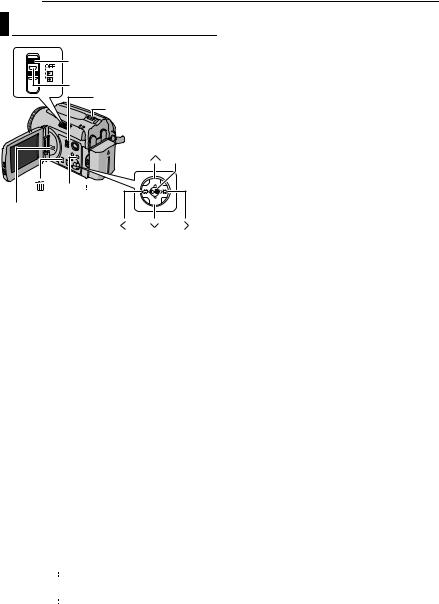
24 EN VIDEO RECORDING & PLAYBACK
Video Playback |
To play back files in the [EXTMOV] folder |
|
If the data cannot be recorded properly, the |
||
|
video files are saved to the [EXTMOV] folder. |
|
|
( pg. 22) |
|
Power Switch |
To play back the files in the [EXTMOV] folder, |
|
|
press the recording start/stop button or START/ |
|
Lock Button |
STOP button on the remote control while the |
|
index screen is displayed in step 2, and then |
||
MODE |
||
proceed to step 3 after [MPG] is displayed. |
||
Zoom Lever |
||
To return to the index screen, press the |
||
|
||
|
recording start/stop button or START/STOP |
|
|
button on the remote control again. |
|
|
● The file information and playlist creation functions |
|
49 |
are not available for files in the [EXTMOV] folder. |
|
|
● When you delete the files in the [EXTMOV] folder, |
|
|
perform it on the PC. |
INFO/
Speaker
1 Set the power switch to  .
.
2 Set the MODE switch to .
.
●The index screen for videos appears. The image on the index screen shows the first part of the shooting.
●If the power is turned off while video playback is paused, the camera memorizes the scene where the video was stopped. In this case, the stopped scene is displayed when the power is turned back on again.
●To switch the medium to be played back, see pages 21, 48 and 49.
3 Press  /
/ /
/  /
/  to select the video file you want to play back.
to select the video file you want to play back.
4 Press 49 to start playback.
5 To pause playback, press 49 again.
To return to the index screen
Slide the zoom lever to W when playback is paused.
To adjust the speaker volume
During playback slide the zoom lever towards T to turn up the volume, or towards W to turn down the volume.
To turn on/off the date display
NOTES:
●The playback picture can be viewed in the LCD monitor or on a connected TV. ( pg. 26)
●At the junctions between scenes, the image may stop momentarily or the sound may be interrupted. However, this is not a malfunction.
●The date and counter can be displayed during playback. ( pg. 49)
●When the camera heats up, the U indicator flashes. If the camera continues to heat up, playback may be stopped to protect the recording medium. In this case, turn off the camera power, and then wait until the camera cools down.
( pg. 56)
●When a cable is connected to the AV connector, the sound is not heard from the speaker.
Set [DATE/TIME] to [ON], [AUTO] or [OFF]. ( pg. 48, 49)
To turn on/off the on-screen display
Press INFO/
 repeatedly.
repeatedly.
To check the file information
Press INFO/
 when playback is paused. ( pg. 38)
when playback is paused. ( pg. 38)
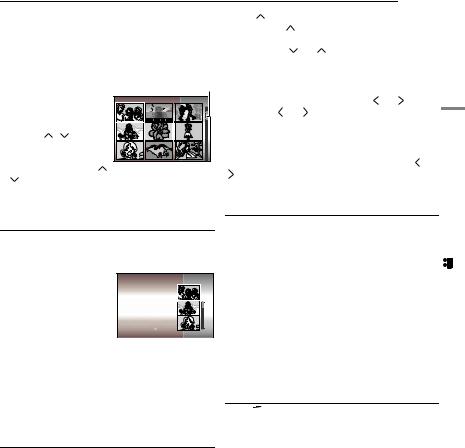
VIDEO RECORDING & PLAYBACK EN 25
How to Use the Scroll Bar |
Press |
to locate the start point of the current |
|||
|
file. Pressing |
repeatedly skips files in reverse |
|||
You can use the vertical scroll bar on the index |
|||||
direction. |
|
|
|
||
screen to find the desired files quickly. The scroll |
|
|
|
||
● If you press |
or |
during normal playback |
|||
bar is useful when deleting files ( pg. 39), |
or search, playback resumes after locating the |
||||
creating play list ( pg. 42), etc. |
start point of a file. |
|
|||
1 Slide the zoom lever |
|
Scroll bar |
Frame-by-frame playback |
|
|
||||
towards W to select the |
VIDEO |
7/53 |
While playback is paused, press |
or . |
|
||||
scroll bar on the index |
|
|
● Pressing |
or |
repeatedly advances or |
|
|||
screen. |
|
|
|
|
|
||||
|
|
|
|
reverses the still picture frame by frame. |
|
||||
2 Press |
/ |
to |
|
|
|
||||
|
|
● To resume normal playback, press 49. |
|
||||||
display the next or |
|
|
Slow motion playback |
|
|
||||
previous page. |
|
|
|
|
|
||||
|
|
|
While playback is paused, press and hold |
or |
|||||
● If you press and hold |
/ |
|
|||||||
|
for over 2 seconds. |
|
|
||||||
, the high speed search starts. |
|
|
|
||||||
|
● To stop slow motion playback, press 49. |
|
|||||||
● If you find the desired file, slide the zoom lever |
|
||||||||
|
|
|
|
|
|||||
towards T, then select the file. |
|
Playback Zoom |
|
|
|
||||
|
|
|
|
|
|
|
|
||
Date Index Screen
You can also find the desired file by the date index screen. The files are sorted according to their recorded date.
1 Slide the zoom lever
DATE INDEX
twice towards W. The date index screen appears.
2 Press  /
/  to select the desired date. The
to select the desired date. The
files recorded on the selected date are displayed on the right side of the screen.
●To display the next or previous date, select the scroll bar by sliding the zoom lever towards W, and press  /
/  .
.
3 Press 49. The files recorded on the selected date are displayed in the index screen.
You can magnify the playback image up to 5x.
1 During normal playback, at the point you want to zoom in, press 49 to pause playback.
2 Slide the zoom lever towards T to zoom in.
●The full view of the image is displayed in the small screen on the lower right side. The * mark indicates the centre point of the magnified area.
3 Press  /
/  /
/  /
/  to move to the magnified area you want to view.
to move to the magnified area you want to view.
4 To zoom out, slide the zoom lever towards W.
●When the zoom is set all the way to W (wideangle) side, sliding the zoom lever to W switches the display to the index screen. ( pg. 25)
Deleting Video Files
Press  , then press
, then press  /
/  to select [EXECUTE] and press 49.
to select [EXECUTE] and press 49.
Various Playback Operations
Still playback (Pause)
Press 49 during normal playback.
● To resume normal playback, press 49 again.
Search playback
During normal playback, press  for forward search, or
for forward search, or  for reverse search.
for reverse search.
●Pressing  or
or  repeatedly increases the search speed for each direction. (–60x to +60x)
repeatedly increases the search speed for each direction. (–60x to +60x)
●To resume normal playback, press 49.
Locating the start point of the file or skip the file
Press  to locate the start point of the next file. Pressing
to locate the start point of the next file. Pressing  repeatedly skips files in forward direction.
repeatedly skips files in forward direction.
●You can select the desired file to be deleted by pressing  /
/  .
.
●To delete multiple files at once, see page 39.
VIDEO RECORDING & PLAYBACK
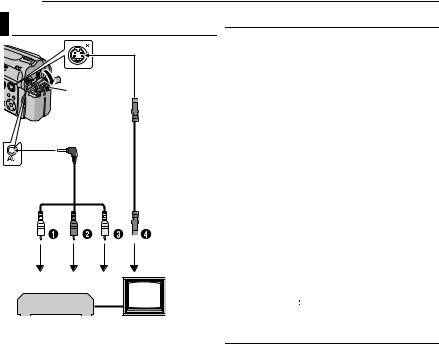
26 EN VIDEO RECORDING & PLAYBACK
Connecting to a TV, VCR or VDR |
Playback on a TV |
||
1 Make sure all units are turned off. |
|||
|
|
||
|
To S connector |
2 Connect the camera to a TV, VCR or VDR as |
|
|
|
shown in the illustration. |
|
Open the |
|
If using a VCR or VDR, go to step 3. |
|
|
If not, go to step 4. |
||
cover. |
|
3 Connect the VCR/VDR output to the TV |
|
|
|
||
|
|
input, referring to your VCR/VDR’s instruction |
|
To AV connector |
|
manual. |
|
|
|
4 Turn on the camera, the VCR/VDR and the |
|
|
|
TV. |
|
AV Cable |
S Cable |
5 Set the VCR/VDR to its AUX input mode, and |
|
(optional) |
|||
(provided) |
|
set the TV to its VIDEO mode. |
|
|
|
6 Start playback on the camera. ( pg. 24) |
|
|
|
To choose whether or not the following |
|
|
|
displays appear on the connected TV |
|
VCR/VDR |
TV |
●Date/Time
Set [DATE/TIME] to [AUTO], [ON] or [OFF]. ( pg. 48, 49)
●Counter
Set [SCENE COUNTER] to [ON] or [OFF]. ( pg. 48, 49)
(Pressing INFO/
 button also turns on/off the displays.)
button also turns on/off the displays.)
Dubbing to a VCR (or DVD Recorder)
A White to AUDIO L IN* B Red to AUDIO R IN*
C Yellow to VIDEO IN (Connect when your TV/ VCR/VDR has only A/V input connectors.)
D Black to S-VIDEO IN (Connect when your TV/ VCR/VDR has S-VIDEO IN and A/V input connectors. In this case, it is not necessary to connect the yellow video cable.)
* Not required for watching still images only.
NOTES:
●The S-Video cable is optional. Be sure to use the YTU94146A S-Video cable. Consult the JVC Service Centre described on the sheet included in the package for details on its availability. Make sure to connect the end with a core filter to the camera. The core filter reduces interference.
●It is recommended to use the AC adapter as the power supply instead of the battery pack. ( pg. 16)
●Make sure you adjust the TV sound volume to its minimum level to avoid a sudden burst of sound when the camera is turned on.
●To connect the camera to a PC, refer to the software installation and USB connection guide.
The following explains how to dub to a VCR. When dubbing to a DVD recorder, refer to its instruction manual.
1
2 At the point you want to start dubbing, start recording on the VCR. (Refer to the VCR’s instruction manual.)
3 To stop dubbing, stop recording on the VCR, then stop playback on the camera.
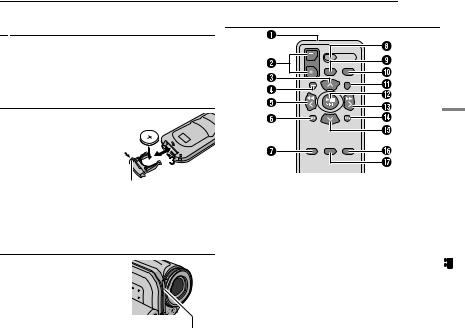
VIDEO RECORDING & PLAYBACK EN 27

 Playback Using the Remote Control Buttons and Functions
Playback Using the Remote Control Buttons and Functions
The full-function remote control unit can operate this camera from a distance as well as the basic operations (playback, stop, pause, fast-forward and rewind) of your VCR.
Installing the Battery |
|
|
The remote control uses |
2 |
|
one lithium battery |
||
|
||
(CR2025). |
1 |
|
1 Pull out the battery |
||
1 |
||
holder by pushing the lock |
||
tab. |
Lock tab |
2 Insert the battery in the
holder, and be sure to have the “+” mark visible.
3 Slide the holder back in until you hear a click.
Beam Effective Area
When using the remote |
|
|
control, be sure to point it at |
|
|
the remote sensor. The |
|
|
transmitted beam’s |
|
|
approximate effective |
|
|
distance for indoor use is 5 m. |
|
|
Use the remote control in |
Remote sensor |
|
front of the camera facing |
||
|
||
toward the lens. |
|
NOTE:
The transmitted beam may not be effective or may cause incorrect operation when the remote sensor is directly exposed to sunlight or powerful lighting.
A Infrared Beam Transmitting Window
● Transmits the beam signal.
B ZOOM (T/W) Buttons Zoom In/Out ( pg. 23)
C Up Button
Rotate Button (clockwise) ( pg. 30) D Skip Backward Button
E Left Button
F Back Button
G PLAYLIST Button ( pg. 42) H START/STOP Button
I SNAPSHOT Button ( pg. 28) J INFO Button ( pg. 38)
K Skip Forward Button
L PLAY/PAUSE Button M Right Button
N Next Button
O Down Button
Rotate Button (counterclockwise) ( pg. 30) P INDEX Button
Q DATE Button
VIDEO RECORDING & PLAYBACK

28 EN STILL IMAGE RECORDING & PLAYBACK

 Still Image Recording
Still Image Recording
 Power Switch
Power Switch
 Lock Button
Lock Button
 Zoom Lever
Zoom Lever
MODE
Recording Start/Stop
Button
1 Set the power switch to  .
.
2 Set the MODE switch to  .
.
●The camera is programmed to record still images on the built-in hard disk by the factory-preset. To switch the recording medium, see pages 21, 48 and 49.
●To change the picture quality, see pages 48 and 51.
●To use the light, see page 31.
3 Press the recording start/stop button. PHOTO indicator appears during shooting. The still image is recorded.
●To check how the image looks before recording, press the recording start/stop button halfway and hold. The  indicator appears and stops blinking when the captured image is focused. To cancel the recording, release the recording start/stop button. To record it on the recording medium, press the recording start/stop button fully.
indicator appears and stops blinking when the captured image is focused. To cancel the recording, release the recording start/stop button. To record it on the recording medium, press the recording start/stop button fully.
NOTES:
●There may be differences in the brightness between the recorded video and still image, even if the same subject is shot.
●To turn the shutter sound off, see page 48.
●For approximate number of storable images, see page 63.
Zooming
Use the zoom function for close-up or wideangle shooting. For details, see page 23.
Continuous Shooting
If the continuous shooting mode is set to on, keeping the recording start/stop button pressed in step 3 in “Still Image Recording” ( pg. 28) provides an effect similar to serial photography. (Interval between still images: approx. 0.5 seconds)
To use this function, set the [CONTINUOUS SHOOTING] to [ON]. ( pg. 51) The  indicator appears on the display.
indicator appears on the display.
●To turn off this function, set [CONTINUOUS SHOOTING] to [OFF].
●Continuous shooting may not work well depending on the recording medium.
●The continuous shooting speed will drop when repeatedly making continuous shots.
Deleting Files
If you press  during recording mode, the file recorded most recently will be deleted.
during recording mode, the file recorded most recently will be deleted.
( pg. 39)
●However, if the recording mode (video or still image) is switched or the power is turned off and on again after recording, you cannot delete the file.
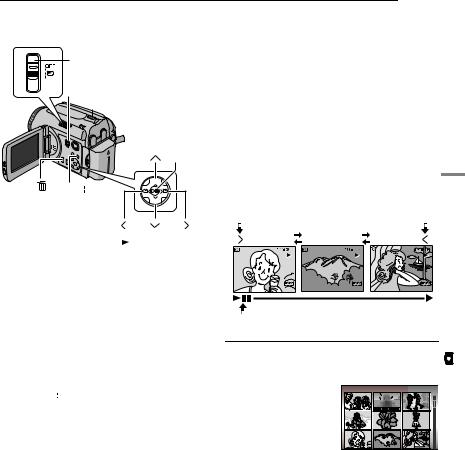
STILL IMAGE RECORDING & PLAYBACK EN 29
|
|
Still Image Playback |
Slide Show |
|
|
|
|||
|
|
You can playback all the images stored in |
||
|
|
|
|
|
|
|
|
|
|
|
|
|
|
recording media automatically. |
 Power Switch
Power Switch

 Lock Button
Lock Button
 MODE
MODE
 Zoom Lever
Zoom Lever
49
INFO/
1 Set the power switch to  .
.
2 Set the MODE switch to
●The most recently shot still image is displayed.
●To switch the medium to be played back, see pages 21, 48 and 49.
3 Press  to display the previous file. Press
to display the previous file. Press  to display the next file.
to display the next file.
1 Set the power switch to  .
.
2 Set the MODE switch to  .
.
●A still image is displayed.
●To switch the medium to be played back, see pages 21, 48 and 49.
3 Press 49 to start the slide show.
●If you press  during the slide show, files are displayed in descending order.
during the slide show, files are displayed in descending order.
●If you press  during the slide show, files are displayed in ascending order.
during the slide show, files are displayed in ascending order.
●To end the slide show, press 49 again.
To display the next |
To display the |
image |
previous image |
Normal Playback
Slide Show
To turn on/off the date/time display
Set [DATE/TIME] to [ON], [AUTO] or [OFF]. ( pg. 48, 49)
To turn on/off the on-screen display / To check the file information ( pg. 38)
Press INFO/
 repeatedly.
repeatedly.
NOTES:
●Images shot and stored on the recording media with another device may not be played back correctly.
●You can zoom in/out or rotate still images. ( pg. 30)
Index Screen of Still Image Files
You can view multiple files stored in a recording medium at a time. This browsing capability makes it easy to locate a particular file you want.
1 Slide the zoom lever STILL IMAGE
to W when a recorded image is displayed.
● The display switches to the index screen.
2 Press  /
/  /
/  /
/  to move the frame to the desired file.
to move the frame to the desired file.
7/53 |
3 Press 49. The selected file is displayed.
STILL IMAGE RECORDING & PLAYBACK
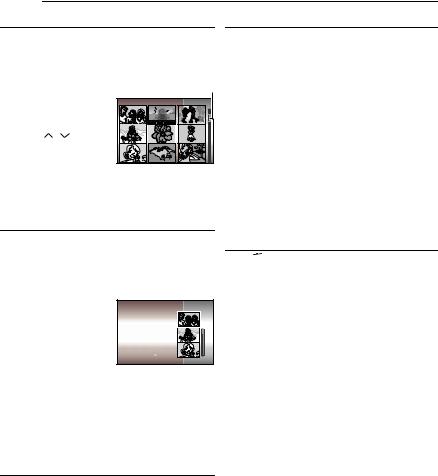
30 EN STILL IMAGE RECORDING & PLAYBACK
How to Use the Scroll Bar |
Playback Zoom |
You can use the vertical scroll bar on the index screen to find the desired files quickly. The scroll bar is useful when deleting files ( pg. 39), setting DPOF ( pg. 46), etc.
1 Slide the zoom lever |
|
Scroll bar |
|||
towards W to select the |
STILL IMAGE |
7/53 |
|||
scroll bar on the index |
|||||
|
|
||||
screen. |
|
|
|
|
|
2 Press |
/ |
to |
|
|
|
display the next or |
|
|
|||
previous page. |
|
|
|
||
●If you press and hold  /
/
 , the high speed search starts.
, the high speed search starts.
●If you find the desired file, slide the zoom lever towards T, then select the file.
Date Index Screen
You can magnify the playback image up to 5x.
1 Set the power switch to  .
.
2 Set the MODE switch to  .
.
●A still image is displayed.
●To switch the medium to be played back, see pages 21, 48 and 49.
3 Slide the zoom lever towards T to zoom in.
●The full view of the image is displayed in the small screen on the lower right side. The * mark indicates the centre point of the magnified area.
4 Press  /
/  /
/  /
/  to move to the magnified area you want to view.
to move to the magnified area you want to view.
5 To zoom out, slide the zoom lever towards W.
●When the zoom is set all the way to W (wideangle) side, sliding the zoom lever to W switches the display to the index screen. ( pg. 29)
You can also find the desired file by the date index screen. The files are sorted according to their recorded date.
1 Perform step 1 in “Index Screen of Still Image Files” ( pg. 29) to dispaly the index screen.
2 Slide the zoom lever
twice towards W. The DATE INDEX date index screen appears.
3 Press  /
/  to select the desired date. The
to select the desired date. The
files recorded on the selected date are displayed on the right side of the screen.
●To display the next or previous date, select the scroll bar by sliding the zoom lever towards W, and press  /
/  .
.
4 Press 49. The files recorded on the selected date are displayed in the index screen.
Image Rotation
You can rotate a still image clockwise or counterclockwise.
1 Set the power switch to  .
.
2 Set the MODE switch to  .
.
●A still image is displayed.
●To switch the medium to be played back, see pages 21, 48 and 49.
3 Press  to rotate 90° clockwise.
to rotate 90° clockwise.
●Each time you press  , the image rotates clockwise. (90° ] 180° ] 270° ] 0°)
, the image rotates clockwise. (90° ] 180° ] 270° ] 0°)
4 Press  to rotate 90° counterclockwise.
to rotate 90° counterclockwise.
Deleting Still Image Files
Press  , then press
, then press  /
/ to select [EXECUTE] and press 49.
to select [EXECUTE] and press 49.
●You can select the desired file to be deleted by pressing  /
/  .
.
●To delete multiple files at once, see page 39.
●Each time you press  , the image rotates counterclockwise. (270° ] 180° ] 90° ] 0°)
, the image rotates counterclockwise. (270° ] 180° ] 90° ] 0°)
